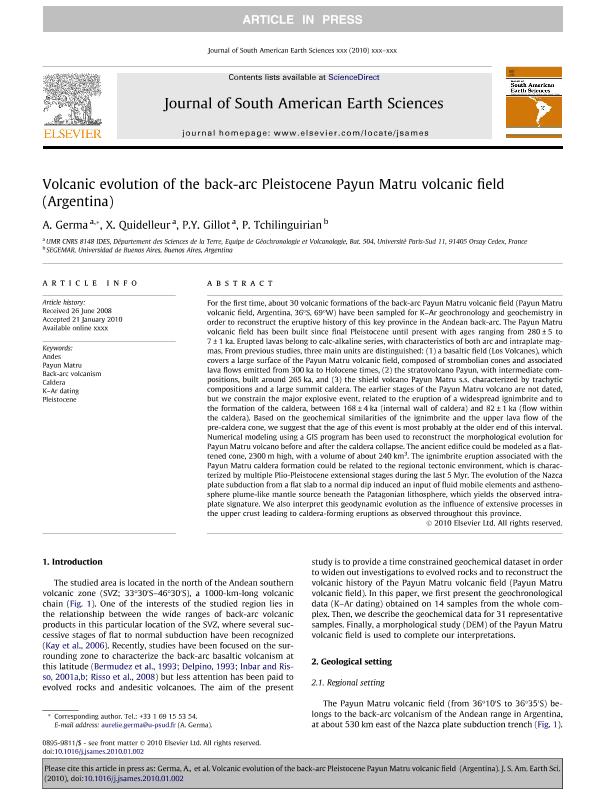Artículo
Volcanic evolution of the back-arc Pleistocene Payun Matru volcanic field (Argentina)
Fecha de publicación:
04/2010
Editorial:
Pergamon-Elsevier Science Ltd
Revista:
Journal of South American Earth Sciences
ISSN:
0895-9811
Idioma:
Inglés
Tipo de recurso:
Artículo publicado
Clasificación temática:
Resumen
For the first time, about 30 volcanic formations of the back-arc Payun Matru volcanic field (Payun Matru volcanic field, Argentina, 36°S, 69°W) have been sampled for K-Ar geochronology and geochemistry in order to reconstruct the eruptive history of this key province in the Andean back-arc. The Payun Matru volcanic field has been built since final Pleistocene until present with ages ranging from 280±5 to 7±1ka. Erupted lavas belong to calc-alkaline series, with characteristics of both arc and intraplate magmas. From previous studies, three main units are distinguished: (1) a basaltic field (Los Volcanes), which covers a large surface of the Payun Matru volcanic field, composed of strombolian cones and associated lava flows emitted from 300ka to Holocene times, (2) the stratovolcano Payun, with intermediate compositions, built around 265ka, and (3) the shield volcano Payun Matru s.s. characterized by trachytic compositions and a large summit caldera. The earlier stages of the Payun Matru volcano are not dated, but we constrain the major explosive event, related to the eruption of a widespread ignimbrite and to the formation of the caldera, between 168±4ka (internal wall of caldera) and 82±1ka (flow within the caldera). Based on the geochemical similarities of the ignimbrite and the upper lava flow of the pre-caldera cone, we suggest that the age of this event is most probably at the older end of this interval. Numerical modeling using a GIS program has been used to reconstruct the morphological evolution for Payun Matru volcano before and after the caldera collapse. The ancient edifice could be modeled as a flattened cone, 2300m high, with a volume of about 240km3. The ignimbrite eruption associated with the Payun Matru caldera formation could be related to the regional tectonic environment, which is characterized by multiple Plio-Pleistocene extensional stages during the last 5Myr. The evolution of the Nazca plate subduction from a flat slab to a normal dip induced an input of fluid mobile elements and asthenosphere plume-like mantle source beneath the Patagonian lithosphere, which yields the observed intraplate signature. We also interpret this geodynamic evolution as the influence of extensive processes in the upper crust leading to caldera-forming eruptions as observed throughout this province.
Palabras clave:
ANDES
,
BACK-ARC VOLCANISM
,
CALDERA
,
K-AR DATING
,
PAYUN MATRU
,
PLEISTOCENE
Archivos asociados
Licencia
Identificadores
Colecciones
Articulos(SEDE CENTRAL)
Articulos de SEDE CENTRAL
Articulos de SEDE CENTRAL
Citación
Germa, A.; Quidelleur, X.; Gillot, P.Y.; Tchilinguirian, Pablo; Volcanic evolution of the back-arc Pleistocene Payun Matru volcanic field (Argentina); Pergamon-Elsevier Science Ltd; Journal of South American Earth Sciences; 29; 3; 4-2010; 717-730
Compartir
Altmétricas




